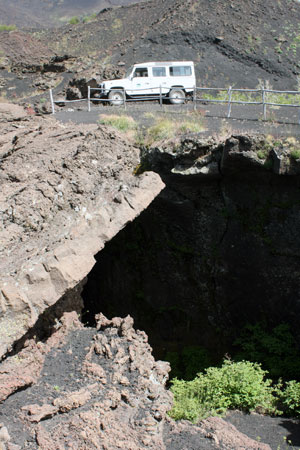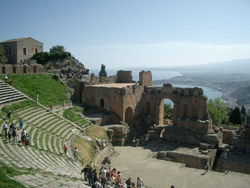Etna excursions: Etna and taormina
This trip lasts about 6-7 hours
 Visit the most typical towns on the slopes of the highest volcano in Europe:
Santa Venerina, Zafferana.... visit on the way some old lava flows, and during the ascent different kinds of vegetation can be noted.
Visit the most typical towns on the slopes of the highest volcano in Europe:
Santa Venerina, Zafferana.... visit on the way some old lava flows, and during the ascent different kinds of vegetation can be noted.
We will reach 2.000 meters (7.000 ft) where we then take a walk together to visit the "Silvestri Craters" (1986) and the lates
new lava flows and craters from 2001 / 2002 / 2003
We will then visit a local family farm where it is possible to taste local Etna wine.
We will then drive you to the beautiful town of Taormina.
Taormina
Taormina, with its corners, its atmospheres and its colours, has always bewitched anyone who comes to visit it.
The charm of ôthe pearl of the Ionian seaö has remained unchanged through times.
 The birth of the city was due to the settlement of some Greek sailors coming from the near Naxos. With this first domination,
Tauromenion (this is its first name) took the typical form of the Greek colonies, from the buildings of AgorÓ and Bouleterion,
necessary centre of the city council.
The birth of the city was due to the settlement of some Greek sailors coming from the near Naxos. With this first domination,
Tauromenion (this is its first name) took the typical form of the Greek colonies, from the buildings of AgorÓ and Bouleterion,
necessary centre of the city council.
The construction of what is rightly regarded as the civic symbol, the famous Ancient Theatre, goes back to this period.
It was built in the 3rd century Before Christ, using the morphology of the hill; it is surrounded by a breathtaking view, including two
geographical extremes: the Bay of Schis˛ and volcano Etna.
After Greek people, the Romans were spellbound by this patch of heaven; their main undertaking was the renovation of countless inherited pieces of
architectural work. For instance, the Romans changed the famous Theatre into an Amphitheatre.
Etna
Mount Etna is one of the most active volcanos in the world and the highest and largest in Europe.
It is in fact 11.000 ft and covers an area of 606 sq mi. It is the result of very ancient submarine eruptions in the gulf, which started in the
Quaternary period, about 500.000 years ago, following movement between the tectonic plates: this released magma up to the ocean
floor into the area now occupied by Acicastello and caused surges of lava and vapour which settled in the vicinity of modern day-Patern˛.




